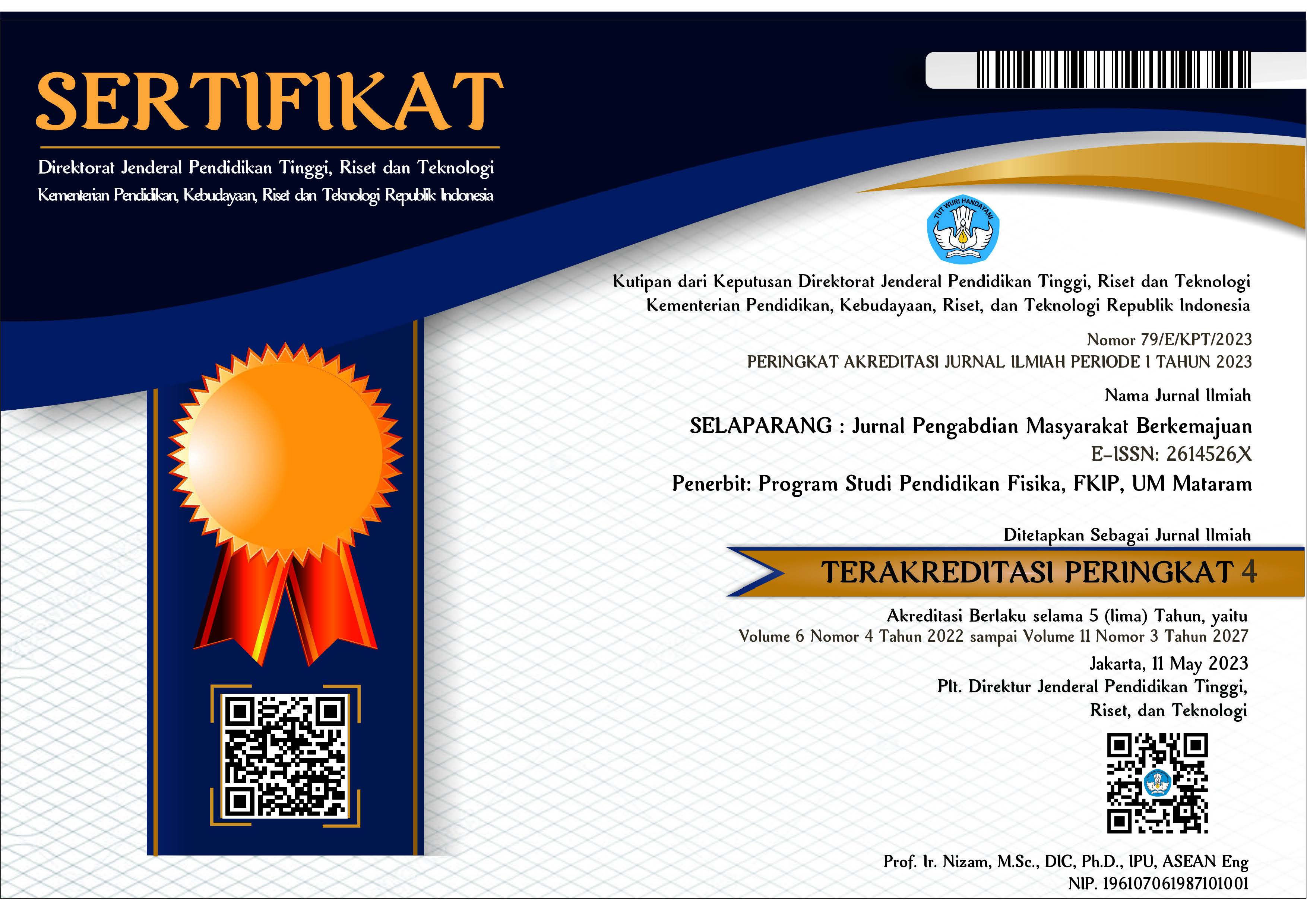BUDIDAYA TANAMAN CABAI MERAH DALAM POT SEBAGAI STIMULUS ANAK USIA DINI DENGAN METODE PROJECT BASED LEARNING
Abstract
ABSTRAK
Anak usia dini (0-6 tahun) memerlukan banyak stimulus perkembangan fisik dan otak hingga mencapai titik optimal. Pola kecerdasan pertumbuhan dicerminkan pada tiga macam bagian yaitu IQ, EQ, dan SQ. Anak-anak usia dini pada pemusatan belajar Arena Belajar KIDS masih memiliki kecenderungan untuk bermain gadget hingga lupa waktu. Salah satu solusinya adalah mengajak para siswa untuk menanam cabai di dalam pot. Bahan yang digunakan adalah bibit tanaman cabai merah, media tanam berupa tanah, pasir, dan kompos serta ditambahkan sekam pada permukaan tanah. Rasio antara tanah, pasir, dan kompos yang digunakan adalah 2:1:1 (v/v). Setelah empat bulan sejak acara pembukaan dan penyemaian benih cabai merah, terdapat 21 tanaman yang berhasil tumbuh dengan baik dengan rerata 37,38 cm; 4,5 buah; 44,71 buah secara berturut-turut tinggi tanaman, jumlah cabang, dan daun pada tanaman. Tingkat keberhasilan program penanaman cabai dalam pot sebesar 70% yang didorong dari hasil verifikasi para wali murid melalui kuisioner. Hasil verifikasi tersebut menyatakan bahwa program menstimulasi motorik anak dengan rerata baik (3,25). Diharapkan kerja sama dengan mitra terus berlanjut yang mengajak para murid untuk lebih peduli dengan lingkungan sekitar, seperti pembuatan kebun sayur terpadu atau perakitan hidroponik sebagi unjuk stimulus motorik pada anak usia dini.
Kata kunci: cabai merah; media tanam; kecerdasan; usia dini
ABSTRACT
Early childhood (0-6 years) requires additional stimulus for physical and brain development to reach the optimal point. The intelligence growth pattern is reflected in three kinds of parts, namely IQ, EQ, and SQ. Children in the KIDS Learning Arena learning center still have a tendency to play with gadgets so they forget the time. The solution invited children to plant chilies in pots. The materials used are red chili plant seeds, planting media in the form of soil, sand, and compost then rice husk addition on surface level. The ratio between soil, sand, and compost was used at 2:1:1 (v/v). After four months after the opening and seeding of red chilies, there were 21 plants that managed to grow well with an average of 37.38 cm; 4.5 pieces; 44.71 fruit respectively plant height, number of branches, and leaves on the plant. The success rate of the chili planting program in pots is 70% which drove the results by their teacher verification through questionnaires with a good average (3.25). Hopefully, the cooperation will continue to encourage students to care more about its environment, such as building an integrated vegetable garden or hydroponic assembly as a demonstration of motor stimulation in early childhood.
Keywords: red chilli; cultivation media; intelligence; child
Keywords
Full Text:
PDFReferences
Amini, M., & Aisyah, S. (2014). Hakikat Anak Usia Dini. In Perkembangan Dan Konsep Dasar Pengembangan Anak Usia Dini (Vol. 65).
Ariyanti, T. (2016). The importance of childhood education for child development. Jurnal Online Universitas Muhammadiyah Purwokerto, 50–58.
Hidayat, J. P., Hariyadi, A., & Chosta, F. (2022). Bentonite and RHA adsorption performance against characteristics waste-cooking oil. J. Sains & Tek. Pangan, 7(6), 5600–5614.
Hidayat, J. P., Robiandi, F., Arisalwadi, M., & Hariyadi, A. (2022). Opportunity of durian seed flour as an alternative to commercial wheat flour. Journal of Agritechnology and Food Processing, 2(2), 54–67.
Kumoro, A. C., & Hidayat, J. P. (2018). Effect of soaking time in sodium metabisulfite solution on the physicochemical and functional properties of durian seed flour. MATEC Web of Conferences, 156. https://doi.org/10.1051/matecconf/201815601028
Latifah, E., Andri, K. B., & Mariyono, J. (2014). Introduction the model of school vegetable garden to increased consumption of vegetables for students in Kediri-East Java. Agriekonomika, 3(1), 34–44. http://agribisnis.trunojoyo.ac.id/agriekonomika
Miranti, P., & Putri, L. D. (2021). Waspadai dampak penggunaan gadget terhadap perkembangan sosial anak usia dini. Jurnal Cendekiawan Ilmiah PLS, 6(1), 58–66.
Purba, T., Situmeang, R., Rohman, H. F., Mahyati, Arsi, Firgiyanto, R., Junaedi, A. S., Saadah, T. T., Junairiah, Herawati, J., & Suhastyo, A. A. (2021). Pupuk dan Teknologi Pemupukan (R. Watrianthos, Ed.; 1st ed.). Yayasan Kita Menulis.
Rosdiana, Asaad, H. M., & Mantau, Z. (2011). Teknologi Budidaya Cabai Rawit. Balai Pengkajian Teknologi Pertanian.
Statistik, B. P. (2021). Akses anak usia 5 tahun ke atas terhadap media sosial.
Stroud, K. A., & Booth, D. J. (2003). Advanced Engineering Mathematics (4th ed.).
Sujiono, Y. N. (2013). Pendidikan Anak Usia Dini (B. Sarwiji, Ed.; 1st ed.). PT Indeks.
Warnita, & Aisman. (2017). Community empowerment through red chilli cultivation in pot. Logista, 1(2), 41–50.
Warnita, & Herawati, N. (2017). Effect of naphthalene acetic acid (NAA) and foliar fertilizer concentration on the growth of ornamental plants Anthurium “wave of love” (Anthurium plowmanii). Pros. Sem. Nas. Masy. Biodiv. Indon, 69–74. https://doi.org/10.13057/psnmbi/m030112
Widiwurjani, & Djarwatiningsih. (2016). Pemangkasan pada Tanaman Cabe.
Wiyani, N. A. (2020). Implementation of a Character Education Strategy in the Perspective of Permendikbud Number 23 of 2015 at Raudhatul Athfal. Tarbawi: Jurnal Keilmuan Manajemen Pendidikan, 6(02), 141. https://doi.org/10.32678/tarbawi.v6i02.2934
DOI: https://doi.org/10.31764/jpmb.v7i1.12212
Refbacks
- There are currently no refbacks.

This work is licensed under a Creative Commons Attribution-ShareAlike 4.0 International License.
______________________________________________________
Jurnal Selaparang
p-ISSN 2614-5251 || e-ISSN 2614-526X
EDITORIAL OFFICE:



















